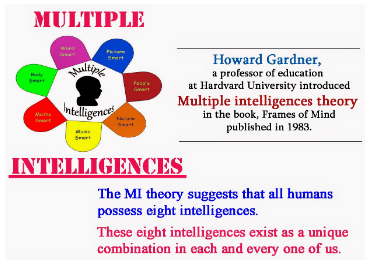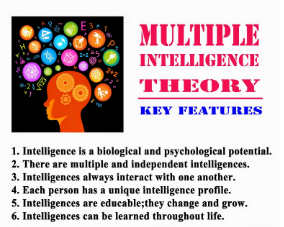Multiple intelligences theory of Howard Gardner's
Howard Gardner's theory of multiple intelligences
The theory of multiple intelligences (MI) was developed in 1983 by Dr. Howard Gardner, professor of education at Harvard University. In his book, Frames of Mind, Gardner described seven distinct types of intelligences-logical-mathematical, verbal-linguistic, visual-spatial, musical, bodily-kinaesthetic, interpersonal and intrapersonal. In the next edition of this book, he added two more types of intelligence – naturalistic and existential intelligence.
According to MI theory, everyone possesses all of the eight bits of intelligence. However, the extent to which each is developed in an individual varies from person to person. Each person has a unique intelligence profile. Gardner claims that intelligence is not fixed, but continually expands and changes throughout one’s life. Gardner regards this intelligence not as skills but as “biological potentials” which are realized to a greater or lesser extent depending upon opportunities and motivation (Gardner 2004). According to Gardner’s theory, one form of intelligence is not better than another; they are equally valuable and viable (Gardner 1983). Multiple intelligence theory challenged the dominant definition of intelligence as limited to linguistic and mathematical abilities (verbal and computational intelligence). G-theory defines intelligence as an innate general capacity to learn that varies in amount from person to person, but which is relatively stable over the life span.
According to Gardner, intelligence is, “the talent to solve problems or produce products that are considered valuable in one or several cultures.” He stated that intelligence can be described as the combination of psychological and biological characteristics that enable individuals to solve problems or create products that are valued in one or more cultures (Gardner 1999). Gardner further suggests that thinking, problem-solving and creating are valued differently depending on the family and community in which individuals live, learn and work.
Gardner proposed that there was eight relatively autonomous but interconnected intelligence:
Verbal/linguistic intelligence (word smart / book smart) - refers to the ability to use language masterfully to express oneself rhetorically or poetically e.g. the writer, orator.
Logical/ mathematical intelligence (number smart/logic smart) - refers to the ability to concentrate on mathematical problems, hypotheses and think logically e.g. the scientist, philosopher.
Visual/spatial intelligence (picture smart/art smart) – refers to the ability to manipulate and create mental images in order to solve problems e.g. the architect, engineer, sculptor.
Bodily/kinaesthetic intelligence (body smart/ movement smart) – refers to the ability to use one’s mind to control one’s bodily movement e.g. the athlete, dancer, actor, surgeon.
Musical/ rhythmic intelligence (music smart/ sound smart) – refers to the ability to read, understand, and compose musical pitches, tones and rhythms e.g. the entertainer, musician.
Interpersonal intelligence (people smart/ group smart) – refers to the ability to apprehend the feelings and intention of others e.g. the counselor, minister, teacher.
Intrapersonal intelligence (self smart/ introspection smart) – refers to the ability to understand one’s own feelings and motivations e.g. the poet, efficiency expert.
Naturalist intelligence (nature smart) – refers to the ability to relate to the natural world with clarity and sensitivity e.g. biologist, environmentalist.
Existential intelligence – refers to the ability to explore complex philosophical questions.
Bases of multiple intelligence theory
According to Gardner, there are biological and cultural bases for multiple intelligences. The neurobiological research indicates that learning is an outcome of the modifications in the synaptic connections between brain cells. The various types of learning result in synaptic connections in different areas of the brain. Since different cultures value different types of intelligence, one’s cultural context plays large roles in the formation of intelligence. There is extensive anthropological evidence indicates that certain intelligence (or abilities) exist in highly evolved levels in certain cultures.
The first claim is that all human beings possess all of the eight bits of intelligence. Of course, the eight bits of the intelligence function together in ways unique to each person. The second claim is that just as we all look different and have different personalities and temperaments, we also exhibit different profiles of intelligence. Gardner suggests that virtually everyone has the capacity to develop all eight bits of intelligence to a reasonably high level of performance if given the appropriate encouragement, enrichment, and instruction. Gardner suggests that intelligence usually work together in complex ways. Gardner argues that most tasks require more than one intelligence working together. Gardner further suggests that there are many ways to be intelligent within each category. There is no set of attributes that one must have to be considered intelligent in a specific area. Multiple intelligence theory emphasizes the rich diversity of ways in which people show their gifts within intelligence as well as between intelligence. Gardner has based his claims for the existence of at least eight intelligence on psychological, neuropsychological, neurobiological, historical and evolutionary evidence as well as on findings from
1. We are born with a unique mix of all eight bits of intelligence.
2. Intelligence combine in complex ways.
3. There are many ways to be intelligent within each category.
4. Most people can develop each intelligence to an adequate level of competency.
5. Each multiple intelligence begins as a biological potential that is shaped exponentially as the individual develops.
Gardner’s theory of multiple intelligences provides a theoretical foundation for recognizing the different abilities and talents of students. Gardner states that students learn in different ways and need a variety of experiences to develop all their ways of learning. Multiple intelligence theory can be used for curriculum development, planning instruction, selection of course activities and related assessment strategies. Using multiple intelligences in classrooms engages different styles of learning in order to maximize educational success, intellectual growth, and enthusiasm among diverse learners.
Managers who have multiple intelligences can understand the challenges face with employees. The highest performing managers and leaders have significantly more ‘multiple intelligence competencies’ than other managers.
Businesses can use multiple intelligence theory to structure workshops and training sessions for employees which will enhance teamwork, develop human potential and foster creativity.
Multiple intelligence theory has applications to education
I hope you like this article "Multiple intelligences theory of Howard Gardner's "If you like then share with your friends
Thanks for Visiting!!
Time defines a period during which an action, process or condition exists or continues. Time is a scarce resource(‘time is gold’). It is more valuable than money as money can be earned (‘time is money’). Time is fixed and we cannot change it. Every human being on earth has the same amount of time -60 seconds in a minute; 60 minutes in an hour; 1,440 minutes in a day and 525,600 minutes in a year. You can't recycle wasted time.
Time management definitions, Rule,Quotes,examples,importance ,Skills,advantages,Barriers and it's purpose
I hope you like this article "
Thanks for Visiting!!
Secrets of strategic thinking
A strategy is an individual’s comprehensive approach to a task. In other words, the strategy is a course of action for achieving an organization’s purpose. To think strategically means to take the long-term view and see the big picture of desired end states and set goals. It is like ‘seeing the forest, not just the trees’ or taking a helicopter ride to a sufficient height to see a big picture (‘helicopter view’ of the firm)."Secrets of strategic thinking"
Time defines a period during which an action, process or condition exists or continues. Time is a scarce resource(‘time is gold’). It is more valuable than money as money can be earned (‘time is money’). Time is fixed and we cannot change it. Every human being on earth has the same amount of time -60 seconds in a minute; 60 minutes in an hour; 1,440 minutes in a day and 525,600 minutes in a year. You can't recycle wasted time.

